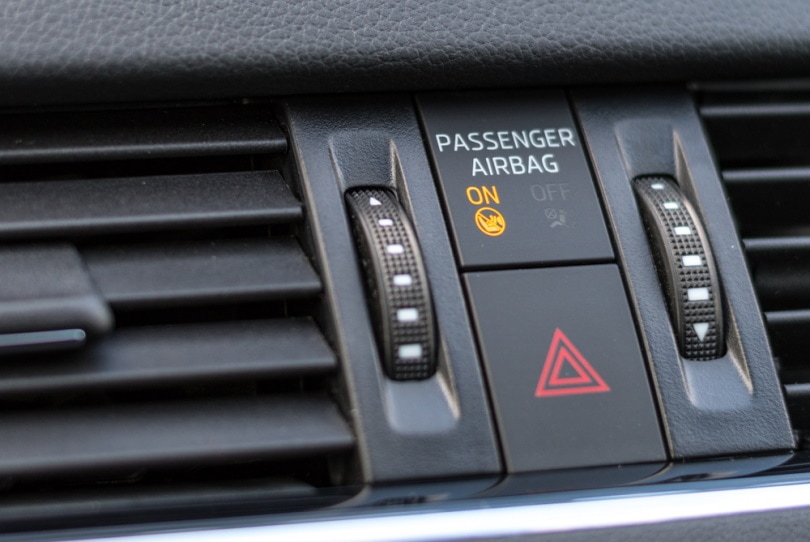When Were Airbags Invented? History, Types, & Future
-

- Last updated:

Airbags are inflatable devices that are a part of mandatory and standard safety equipment in vehicles. They serve as an excellent protective mechanism in case of a collision. These devices brought an enormous breakthrough to the conventional vehicle design, bringing safety and reliability to drivers and their passengers. Since airbags became a standard part of the vehicle’s design, they have reduced the fatality of passengers by 30%. Airbags were invented in 1951.
Airbags had to go a long way to become what they are today—an irreplaceable part of the car’s equipment. To learn the history of the airbag—from the first idea and patent, up until now—read on below.
How Does an Airbag Work?
Airbags work with a very simple process. At the moment of the collision, an airbag opens up to provide a soft pillow between the driver and a hard surface such as the steering wheel or dashboard. An airbag typically consists of three main parts—the impact sensor, inflation module, and the bag. There are multiple airbags located in the car and depending on the angle and power of the collision, the sensors will tell the car which airbags to deploy. After the crash, the airbag will deflate automatically, allowing the passenger to move freely and leave the vehicle.

Types of Airbags
There are two main airbag systems for front and side impact. The frontal airbag systems have sensors that detect the strength of the impact and its location and inflate the driver-side and passenger-side accordingly. The side impact airbags are similar to frontal airbags. They are inflatable devices that protect all the passengers from all impacts coming from the side of the vehicle.
- Head SABs
- Chest SABs
- Head and chest combination SABs
The History of the Airbag
The first idea – 1920
The first concept of the airbag came from two English men—Harold Round and Arthur Parrott. These two innovative minds created bags filled with air that would cover certain vehicle parts and airplanes. Even though this idea was the first to resemble modern airbag systems, the invention of the car airbag happened only 30 years later.
The first patent – 1951
In 1951, American engineer John W. Hetrick invented and patented the first automobile airbag. No major car manufacturer was interested in the product at this point since the first generation of airbags took too long to activate and inflate.
Major improvement – 1964
In the year 1964, the first significant improvement of airbag systems happened. A Japanese engineer, Yasuzaburou Kobori, created a microchemical explosion inside the airbag system to inflate the bags at a much faster and more functional speed.

Electromagnetic sensors – 1967
The second incredible invention of Yasuzaburou Kobori was electromagnetic sensors. These sensors would make the airbag activation much more reliable and predictable. In combination with the micro explosion, the airbag would inflate in fewer than 30 milliseconds.
First commercial use – 1973
In 1973 the Chevrolet Impala featured the first version of the airbag application in mass-market production. General Motors was the first manufacturing company to purchase and use vehicle airbags. Nevertheless, the airbag was discontinued shortly after due to a lack of consumer interest.
Airbags as an alternative to seatbelts – The early 1980s
In the 1980s, several safety concerns regarding rules made seatbelts or airbags mandatory in all new vehicles.

The first historical collision with airbags – 1990
The first airbag-equipped car accident was recorded in 1990; both vehicles were Chrysler LeBaron. The two vehicles collided head-on, causing the driver’s airbags to deploy instantly. Even though the collision was powerful, both drivers suffered only minor injuries.
Both seatbelts and airbags are mandatory – 1998
By 1998, both seatbelts and airbags became mandatory in each new car. Not only was the airbag a requirement, but airbags on both front seats were mandatory.
Advancing technology – The 2000s
The technology of airbags kept advancing until Honda released the first airbag system for motorcycles. The airbags changed and evolved in size, shape, and location. While the front seat airbags were obligatory in each vehicle, the side impact airbags became more popular on expensive vehicles too.

The Future of Airbags
While today’s cars are equipped with incredibly advanced technology and gadgets, it is impossible to predict the future of airbags. However, specific manufacturers are discussing some ideas and plans. Some engineers are working on adding airbag systems for knees. Hyundai predicts that future electric cars will have an advanced airbag system to hug the passenger’s entire body. These airbags would wrap around the passenger, no matter the collision angle.
Airbags have evolved drastically from the first generation of airbags invented in 1951. Engineers and car manufacturers work hard every day to improve the design and quality of the airbag, leading to new ideas and enhancements. While it is impossible to eliminate the fatality of certain collisions, airbags certainly play an essential role in creating a safer and more trustworthy environment.
Final Thoughts
The history of airbags dates back to 1920 when the first idea came to two English men. While these men constructed an airbag for certain parts of vehicles, the first true shape of the modern-day airbag was invented in 1951 by an engineer named John W. Hetrick. The airbag systems have evolved significantly since their first design in 1951 up until the present day. Many adjustments and improvements needed to be made to achieve the functional airbag we know today.
- The History Behind Airbags In Modern Cars
- The Evolution of Airbags in Automobiles: From 1941 to Today
- A Detailed Look At The History Of Airbags
- – New World Encyclopedia
- The GM Airbags of the Swingin’ ’70s
- The Evolution of the Airbag – Auto Mechanic Training School
- The Evolution of the Life-saving Airbags
- The History of Airbags
Featured Image Credit: Maksim Vivtsaruk, Shutterstock
Contents

